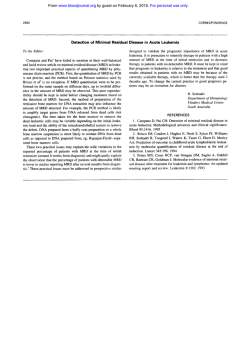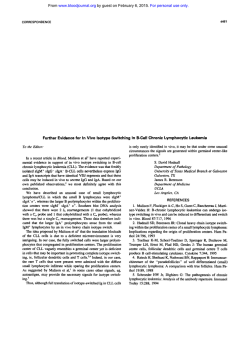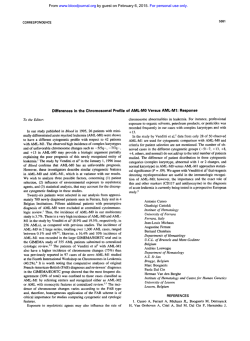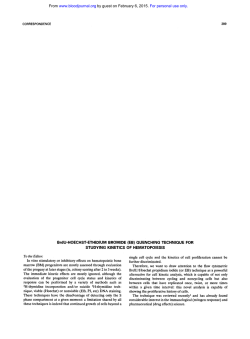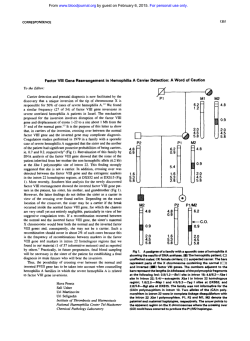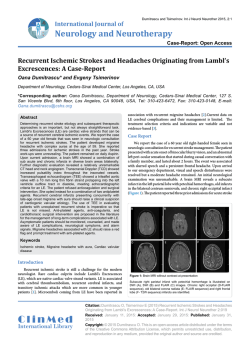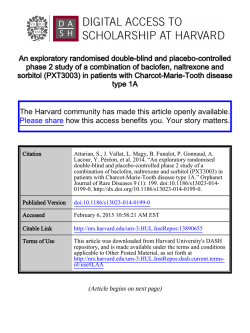
1 Enoxaparin for prevention of unexplained recurrent
From www.bloodjournal.org by guest on February 6, 2015. For personal use only. Blood First Edition Paper, prepublished online January 30, 2015; DOI 10.1182/blood-2014-11-610857 Enoxaparin for prevention of unexplained recurrent miscarriage: a multicenter randomized double-blind placebo-controlled trial Short title: Enoxaparin for prevention of Recurrent Miscarriage Authors: Elisabeth Pasquier,1 Luc de Saint Martin,1 Caroline Bohec,2 Céline Chauleur,3 Florence Bretelle,4 Gisèle Marhic,5 Grégoire Le Gal,6 Véronique Debarge,7 Frédéric Lecomte,8 Christine Denoual-Ziad,9 Véronique Lejeune-Saada,10 Serge Douvier,11 Michel Heisert,12 and Dominique Mottier.6 1 EA 3878 (GETBO) , Department of Internal Medicine and Chest Diseases, Brest University Hospital, La Cavale Blanche Hospital, 29609 Brest, France 2 Division of Gynaecology, François Mitterand Hospital, 64046 Pau, France 3 Division of Gynaecology, Saint Etienne University Hospital, 42055 Saint Etienne, France 4 Division of Gynaecology, Université de la Méditerranée, Hôpital Nord, 13015 Marseille, France 5 CIC-INSERM 1412, La Cavale Blanche Hospital, 29609 Brest, France 6 EA 3878 (GETBO), CIC-INSERM 1412, La Cavale Blanche Hospital, 29609 Brest, France 7 Division of Gynaecology, Lille University Hospital, 59037 Lille 8 Division of Internal Medicine, Bretagne Sud Hospital, 56100 Lorient. 9 Division of Gynaecology, Caen University Hospital, Clemenceau hospital, 14033 Caen 10 Division of Gynaecology, Paris University Hospital, Necker Hospital, 75743 Paris 11 Division of Gynaecology, Dijon University Hospital, Complexe du Bocage, 21079 Dijon 12 Division of Gynaecology, Groupe hospitalier du sud de la Réunion, 97448 Saint Pierre Corresponding author: Elisabeth Pasquier: Tel: 33 (0) 298 347 336; Fax: 33 (0) 298 347 944; E-mail address: [email protected] 1 Copyright © 2015 American Society of Hematology From www.bloodjournal.org by guest on February 6, 2015. For personal use only. This trial is registered with ClinicalTrials.gov, number NCT00740545, and with the French National Health and Drug Safety Agency (ANSM) (EudraCT number: 2006-003350-18). This study was supported by a grant from the French Ministry of Health (PHRC 08-11, 2006). The study sponsor is Brest University Hospital. 2 From www.bloodjournal.org by guest on February 6, 2015. For personal use only. Key Points .The use of low-molecular-weight heparin did not improve live-birth rates in nonthrombophilic women with consecutive recurrent miscarriage. . Prophylactic doses of low-molecular-weight heparin should no longer be prescribed in this clinical setting. 3 From www.bloodjournal.org by guest on February 6, 2015. For personal use only. Abstract Despite the lack of evidence, it is common practice in many centers to offer antithrombotic medications to women with unexplained recurrent miscarriage, in the presence and even absence of inherited thrombophilia. Whereas the absence of benefit of aspirin against placebo has been clearly demonstrated, a double-blind placebo-controlled trial on the effect of lowmolecular-weight heparin is lacking. Before stopping for futility, we enrolled 258 pregnant women, who had a history of unexplained recurrent miscarriage (two or more consecutive miscarriages before 15 weeks’ gestation) and a negative thrombophilia work-up. They were randomly assigned to receive one daily subcutaneous injection of enoxaparin 40 mg or placebo until 35 weeks’ gestation. We included 256 women (mean age: 32 years, 3 or more miscarriages: 72%, mean gestational age: 39 days of amenorrhea) in the intention-to-treat analysis. 66.6% of the 138 who received enoxaparin had a live-birth, compared to 72.9% of the 118 who received placebo. The absolute difference was -6%, 95% CI -17.1 to 5.1, excluding a 10% increase in the rate of live-birth on enoxaparin (p=0.34). In this first randomized double-blind placebo-controlled trial, enoxaparin, 40 mg once daily, did not improve the chance of a live-birth in non-thrombophilic women with unexplained recurrent miscarriage. This trial is registered to www.ClinicalTrials.gov as NCT00740545. 4 From www.bloodjournal.org by guest on February 6, 2015. For personal use only. Introduction Miscarriage, defined as a spontaneous loss of the conceptus before 20 weeks’ gestation, is clinically detected in approximately 10-15 % of pregnancies and recurs in 5% of subsequent pregnancies.1 Recurrent miscarriage is often defined by three or more consecutive losses and affects one to two percent of couples trying to have children.2 However, many experts accept two consecutive losses as sufficient for the diagnosis of recurrent miscarriage because the recurrence rate is close to that after three losses3. In addition, the prevalence of abnormal results for evidence-based diagnostic tests does not differ among women after 2 rather than 3 losses.4 Moreover, distressed women are often referred for care after two losses rather than three. Causes and recurrence rates differ according to the gestational age at miscarriage. Most women have recurrent early loss with a failure of development before 10 weeks, although clinical symptoms most often occur after 10 weeks’ gestation. Therefore, the traditional grouping of all pregnancy losses before 20 weeks has been revised.5 Standard investigations fail to reveal any apparent cause in more than 50% of the couples.1,2 On the basis of a parallel drawn with the antiphospholipid syndrome, hypotheses on thrombotic mechanisms were raised in unexplained pregnancy loss. An association with some inherited thrombophilias was suggested.6,7,8 At the time our study was designed, a randomized open-label trial suggested a strong benefit of low-molecular-weight heparin (LMWH) versus aspirin to improve the live-birth rate in women with at least one previous loss after 10 weeks’ gestation and an inherited thrombophilia.9 This led to extensive use of LMWH as the standard of care in thrombophilic women with recurrent miscarriage. Moreover, despite the lack of such a recommendation in evidence-based guidelines, it had become common practice in many centers to provide 5 From www.bloodjournal.org by guest on February 6, 2015. For personal use only. empirical treatment with low-dose aspirin, prophylactic doses of LMWH or both, for women with unexplained recurrent miscarriage, in the absence of an inherited thrombophilia. Although our goal was to evaluate the efficacy of LMWH in women with recurrent miscarriage regardless of the presence of a known thrombophilia, such a trial would have been deemed unethical in thrombophilic women at that time. Moreover, since nonpharmacological interventions such as psychological support potentially improve the birth rate among women with recurrent miscarriage,2 we strongly felt that a double-blind randomized trial was particularly required to avoid bias.10 Therefore, in 2006, we designed the PREFIX (Prevention of Unexplained Recurrent Abortion by Enoxaparin) study, a randomized double-blind placebo-controlled multi-center trial, to investigate whether LMWH would improve the live-birth rate among nonthrombophilic women. 6 From www.bloodjournal.org by guest on February 6, 2015. For personal use only. Methods Ethics Statement and Trial Registration The study protocol was approved by the local Ethics Committee, the CPP of Brest University Hospital on August 17, 2006 and was registered with the French National Health and Drug Safety Agency (ANSM) on August 25, 2006 (EudraCT number: 2006-003350-18), and on Clinical Trials.gov (number: NCT00740545) on August 22, 2008. Since June 2006, no changes were made to the study outcomes, enrolment criteria, study design or methodology used. All patients provided written informed consent. Study population Between April 4, 2007 and October 31, 2012, women were enrolled in 13 French hospital centers (Bordeaux, Brest, Caen, Dijon, La Réunion, Lille, Lorient, Marseille, Montpellier, Paris, Pau, Rouen, Saint-Etienne). Prior to initiation, the study was advertised to all obstetricians working in each participating center’s catchment area, who were asked to refer potentially eligible women. Inclusion criteria were pregnant woman, aged 18-45 years, with a history of unexplained recurrent miscarriage. The current pregnancy had to be confirmed by a clinician. Recurrent miscarriage was defined by two or more consecutive miscarriages before 15 weeks’ gestation, conceived with the same partner, and without any live births subsequent to the consecutive miscarriages. The definition of miscarriage required both documentation of pregnancy and clinical manifestations of miscarriage but did not include the loss of a biochemical pregnancy (a transient elevation of the level of human chorionic gonadotropin near menses). Unexplained recurrent miscarriage was diagnosed in cases of normal karyotypes of both partners, the absence of any anatomical abnormality likely to be responsible for miscarriage, 7 From www.bloodjournal.org by guest on February 6, 2015. For personal use only. the absence of antiphospholipid syndrome,11 the absence of factor V Leiden and Prothrombin G20210A mutations, the absence of Protein S, C and Antithrombin deficiencies. Exclusion criteria were: women with another indication for aspirin or anticoagulant therapy (e.g. high risk of venous thromboembombolism during pregnancy, chronic antithrombotic therapy for a cardiovascular condition), contraindication to enoxaparin 40 mg injections as per French labeling (e.g. anemia <10g/dl, platelet count <150 x1012/l, creatinine clearance <30 ml/mn), unwilling or unable to consent. Study Design Women were included very early in pregnancy, ideally before 5 weeks’ gestation, after a positive pregnancy test. At the first visit, after confirming eligibility and obtaining consent, women were randomized using a central web-based randomization system (ClinInfo inc., Lyon, France), and received education for self-injections. Blocked randomization (allocation ratio of 1:1, block size of 6) was stratified according to study center and to three levels of disease severity, based on combination of woman’s age and the number of previous miscarriages. This was done in line with a previous longitudinal study on prediction of success rates of subsequent pregnancy (Table 1).12 Women were randomly assigned to receive enoxaparin 40 mg daily or placebo (saline solution). Enoxaparin and placebo were purchased from Sanofi-Aventis (branch ROVI for Placebo-Enoxaparin syringes, Madrid, Spain), then they were packaged and labelled by the pharmacy’s clinical trial unit at Brest university hospital. Enoxaparin and placebo were contained in identical syringes and packed in identical sachets. Treatment was administered subcutaneously once a day, initiated from the inclusion visit (or within 24 hours) and continued by self injection until 35 weeks’ gestation. 8 From www.bloodjournal.org by guest on February 6, 2015. For personal use only. Women were seen in clinics every month until completion of the pregnancy, and one more time 2 months after delivery, by a medical investigator. Pregnancy surveillance, platelet count monitoring, compliance and side effects were addressed during this visit with the use of a structured form. Compliance was assessed by reviewing at each visit a “treatment adherence notebook” in which women were instructed to record daily the time and site of injection. Patients, doctors, and trial nurses were all unaware of the study-group assignments. Women also received standard care and pregnancy monitoring, including fetal ultrasounds, by their own obstetrician, throughout pregnancy. All women were advised to take folic acid supplementation. Outcome Measures The primary outcome measure was the rate of live and viable births. In case of preterm and or low birth weight, we defined the viability by the decision to transfer the new-born to a neonatal intensive care unit. Secondary outcomes included rates of miscarriage, rates of obstetric complications (intrauterine fetal death after 20 weeks’gestation, preeclampsia, birth of a small for gestational age child, placental abruption, and premature delivery), rates of maternal thrombocytopenia (defined as a platelet count <0.6x baseline platelet count or as a platelet count <100,000 per cubic millimeter), bleeding episodes and skin reactions. All information as regards the infant and delivery were collected during the last visit, most often performed around two months after delivery. Obstetrical and pediatric medical reports were retrieved. Statistical analysis 9 From www.bloodjournal.org by guest on February 6, 2015. For personal use only. Baseline characteristics of the study population were expressed as means and standard deviation, or number of patients and proportions, as appropriate. The primary outcome and the rates of different classifications of pregnancy loss were assessed in all women, according to the intention-to-treat principle. Differences in dichotomous outcomes among the two study groups were analyzed with the use of the chi-square test or Fisher’s exact test as appropriate. Differences in live-birth rates were expressed as absolute differences and relative risks, with associated 95% confidence intervals, with the placebo group as the reference. A t-test was used to compare continuous outcome measures. The incidences of preeclampsia, placental abruption, preterm delivery, small size for gestational age, were calculated for women who had an ongoing pregnancy beyond 20 weeks’ gestation. Adverse maternal events and congenital abnormalities were collected for all patients. A per-protocol analysis was also planned, taking into account actual exposure to the assigned study drug. We restricted the analysis to women who were exposed for at least 7 days, and until loss or beyond 12 weeks’ gestation. Additionally, the study drug had to be administered early enough, i.e. before 6 weeks’ gestation, or at least one week before the most advanced term reached during previous pregnancies. Subgroup analyses were conducted in the following sub-groups: maternal age (<35 or ≥35), number of previous miscarriages (2 or ≥3), strata of randomization, parity (presence or absence of previous live birth), history of late fetal death whose causes and recurrence rates may differ (presence or absence of previous fetal death after 10 weeks’ gestation)3. Relative risks for a live birth with enoxaparin compared to placebo were calculated for the separate subgroups. To compare the relative risks among subgroups, we used a test of interaction according to the method described by Atman DG.13 A P value of less than 0.05 was considered to indicate statistical significance. 10 From www.bloodjournal.org by guest on February 6, 2015. For personal use only. Luc de Saint Martin analyzed the data and all authors had access to primary clinical trial data. Sample size In a previous longitudinal study of pregnancy outcome following idiopathic recurrent miscarriage in 325 women,12 75% of the 226 women achieving a further pregnancy had a successful outcome with survival beyond 24 weeks. Thus, when taking into account pregnancy losses occurring after 24 weeks, we assumed that women assigned to receive placebo would have 70% chance of a live and viable birth. On the basis of a minimal clinically important difference of 10 percentage points in live-birth rates, on enoxaparin, we needed to enroll 580 women for a power of 80%, with a two-tailed α of 0.05. We aimed to enroll 610 women, to account for potential lost to follow-up. Study Monitoring According to the study protocol, a data and safety monitoring board,14 whose members were unaware of the study-group assignments, performed two planned blinded interim analyses, after 200 (~one third of the planned inclusions) and 400 women (~two thirds of the planned inclusions) were randomized. The first planned data and safety monitoring board meeting was held on September 4, 2012. The analysis included the data from 207 women in whom the primary outcome had occurred or in whom a miscarriage had occurred by June 1, 2012. On the basis of this analysis, the board advised discontinuation of the study because of futility. The recruitment stopped on October 31, 2012. The study was discontinued on September 2, 2013 after the last woman completed the last visit planned in the protocol. 11 From www.bloodjournal.org by guest on February 6, 2015. For personal use only. Results Study population Among 314 women assessed for eligibility, 258 were enrolled, with 138 assigned to the enoxaparin group, and 120 to the placebo group (Figure 1). Two women immediately withdrew consent before the first injection. Thus the data of 256 women were analysed (138 and 118 women in enoxaparin and placebo groups, respectively). No woman was lost to follow-up yet some did not complete the treatment as planned in the protocol (Figure 1). Only one woman declined injections early after inclusion (3 weeks of injections). Five other patients preferred to stop injections after the first trimester of pregnancy because they were reassured regarding the risk of pregnancy loss and consequently less motivated for the selfinjections. The investigators decided to discontinue the injections in three women (always after the first trimester of pregnancy) because of suspected side effects: cervix bruising (n=1, placebo arm), skin reaction (n=1, enoxaparin arm), thrombocytopenia (n=1, enoxaparin arm). Heparin-induced thrombocytopenia was ruled out in the latter two cases. Baseline characteristics were similar between the study groups and are summarized in Table 1. Mean age was 32 years (range: 18-44 years), 72% of them had three or more previous miscarriages. The mean gestational age at randomization (i.e. time at which the injections were started) was 39 days of amenorrhea. Outcomes Of the 256 women who were included in the intention-to-treat analysis, 178 (69.5%) had a live-birth. The live-birth rates were 66.6% and 72.9% for the enoxaparin and placebo group, respectively. The rates did not differ significantly between groups (absolute difference in livebirth rates -6% [95% CI −17.1 to 5.1; p=0.34]) (Table 2). 12 From www.bloodjournal.org by guest on February 6, 2015. For personal use only. There were 217 women included in the per-protocol analysis. 85 (73.3%) of the 116 women assigned to the enoxaparin group and 74 (73.3%) of the 101 assigned to the placebo group had a live-birth (absolute difference in live-birth rates 0% [95% CI −12 to 12]; p=1) (Table 2). We did not observe any significant difference in secondary outcomes between the two groups (Table 3). During the study, 30.4% of women enrolled in the enoxaparin group, vs. 23.7% in the placebo group suffered another miscarriage (RR 1.28, 95% CI: 0.85 to 1.93). Most of the losses (84.3 %) occurred before ten weeks’ gestation. Maternal adverse events are displayed in Table 3. Seven women (4 in the enoxaparin arm, 3 in the placebo arm) developed thrombocytopenia, but none of them were diagnosed with heparin-induced thrombocytopenia. Two women in the enoxaparin group required blood transfusions after delivery whereas injections were discontinued for more than 10 days. One woman in the enoxaparin group displayed indurations at the injection sites leading to an interruption of the study intervention at 12 weeks’ gestation. Within the two following weeks, she suffered an unexplained intrauterine fetal death. She had no heparin-induced thrombocytopenia (negative ELISA test), and no cause was found to explain the intrauterine death after placenta and foetus examination. Among the premature infants, one in each group died in intensive care unit. There were no significant interactions between the study-group assignment and the number of previous miscarriages, the presence or absence of a previous live birth, the presence or absence of a previous loss after 10 weeks’ gestation, age, or the strata of randomization (Figure 2). 13 From www.bloodjournal.org by guest on February 6, 2015. For personal use only. Discussion In this first reported randomized double-blind placebo-controlled trial, enoxaparin given at the daily dose of 40 mg did not improve the chance of a live birth in non-thrombophilic women with a history of unexplained recurrent miscarriage. Enoxaparin was safe during early pregnancy at the daily dose of 40 mg. Our trial was designed to detect a minimal clinically important difference of 10% in live-birth rates. The upper limit of the 95% confidence interval around the difference in rates of live-birth between groups excludes a 10% benefit with enoxaparin (absolute difference of -6% [95% CI -17.1 to 5.1]). Since initiation of our study in 2006, the results of several randomized trials were reported in unexplained recurrent miscarriage.15-22 Only one was placebo-controlled, the ALIFE study, a randomized trial among all-comer women (around 85% had a negative thrombophilia workup) which amounted to a turning point: the lack of any beneficial effect of aspirin was clearly demonstrated. Additionally, the use of open-label LMWH in combination with aspirin, in a third intervention arm, did not show any improvement in live-birth rates versus oral placebo.18 The SPIN study showed no efficacy of open-label LMWH plus aspirin versus intense pregnancy surveillance alone (all-comer women).19 Yet, a detrimental effect of aspirin could not be ruled out and might explain the lack of efficacy of the combination with LMWH.10,18 As regards the use of LMWH alone, two randomized open-label but underpowered trials did not show a significant benefit of enoxaparin against aspirin,15,20 although in HABENOX,20 the live-birth rate was higher with LMWH (71% vs. 61%, for enoxaparin and aspirin respectively, p: 0.45, all-comer women). Lastly, in a randomized single-blinded trial with some methodological limitations, live-birth rates were significantly higher among women who were assigned to receive enoxaparin than among those assigned to receive a not well-characterized oral placebo (81% vs. 48%); all had a negative hereditary thrombophilia work-up.16 Thus, conclusive data were still lacking concerning the effect of LMWH alone in improving the 14 From www.bloodjournal.org by guest on February 6, 2015. For personal use only. outcome of pregnancy in women with unexplained recurrent miscarriage. This is supported by the last meta-analysis23 in which the authors state that only the data of 6 patients22 could be analyzed as regards the effect of heparin alone versus no treatment, when excluding studies at high risk of bias.16,17 The use of LMWH was supported by some studies, in which a basal prothrombotic state, outside of pregnancy, was measured, in women with previous recurrent miscarriage and without known thrombophilia.24-26 Additionally, heparin and LMWH have other biological properties that could be critical for implantation and placentation.27-35 It is possible, that to be beneficial, heparins may require to be given, at the time of the initial implantation. Our study was not designed to test such a hypothesis. The injections were most often initiated at 5-6 weeks’ gestation, although the instruction was to begin the treatment at the earliest during pregnancy. In the per-protocol analysis taking into account the appropriate exposure to the assigned study drug (early and long enough), the rates of live-birth in each intervention group were similar (73.3%). Likewise, the subgroup analysis did not suggest any clinical benefit from enoxaparin for any subset of patients at higher risk of recurrence. Some other limitations of our study warrant consideration. We initially planned to recruit 305 patients in each group. Nevertheless, physicians, often convinced of LMWH efficacy, were sometimes reluctant to include their patients in the trial, because of placebo injections. As a result, the recruitment was slower than expected. On the basis of the review of the first planned blinded interim analysis, the steering committee decided to prematurely close the study. More than 5 additional years of recruitment would have been necessary to reach statistical significance and it turned out after unblinding treatment allocation, that this would have been to demonstrate superiority of placebo. Another limitation is that this trial did not assess enoxaparin in women with known inherited thrombophilias (factor V Leiden and Prothrombin G20210A mutations, Protein S, C and Antithrombin III deficiencies). No 15 From www.bloodjournal.org by guest on February 6, 2015. For personal use only. previous reported study was designed to robustly examine the sub-group of women with thrombophilia. Noteworthy, in a recently reported open-label trial (TIPPS), 35 among 69 thrombophilic women with previous recurrent miscarriage were randomized to receive antepartum LMWH without any impact on the live birth rate.36 Lastly, we used a broad definition of recurrent miscarriage, more consistent with the current medical practice (i.e., two or more miscarriages). However, about 70% of our patients suffered 3 or more losses, as compared with 100%, 60% and 43% of the women enrolled in HABENOX,20 ALIFE,18 and SPIN,19 respectively. Moreover, in our study, the live-birth rates were 66.6% and 72.9 % in enoxaparin and placebo groups, respectively (p: 0.34). These live-birth rates were consistent with those of the longitudinal study of Brigham et al12 and of the HABENOX20 and ALIFE18 trials, suggesting similar disease severity. Noteworthy, the mean gestational age at miscarriage observed in our study, was similar to the one reported in ALIFE.18 In conclusion, in this first reported randomized double-blind placebo-controlled trial, enoxaparin given at the daily dose of 40 mg did not improve the chance of a live birth in nonthrombophilic women with a history of unexplained recurrent miscarriage. Prophylactic doses of LMWH do not improve the chance of a live birth in non-thrombophilic women with unexplained recurrent miscarriage and should consequently no longer be routinely prescribed in this clinical setting. 16 From www.bloodjournal.org by guest on February 6, 2015. For personal use only. Acknowledgments Clinical investigators: Karine Bages, MD, Gilles Burlet, MD, Michel Collet, PhD, Sandrine Frantz-Blancpain,MD, Anne Genod, MD, Marie-Thérèse LeMartelot, MD, Nathalie Lesavre (CIC of Marseille, hôpital Nord), MD, Agnès Mogenet,MD (CIC of Paris, Necker Hospital), Eric Verspyck, PhD. Pharmacist: Philippe Lorillon This study was supported by a grant (PHRC 08-11, 2006; url: http://www.sante.gouv.fr/IMG/pdf/resultats_PHRC_2006_hors_cancer.pdf) from the French Ministry of Health. The funding source had no role in the design and conduct of the study; collection, management, analysis, and interpretation of the data; preparation, review, or approval of the manuscript; and decision to submit the manuscript for publication. We thank Zarrin Alavi (Inserm, CIC 1412) for proofreading. Authorship Contributions: Study design: Elisabeth Pasquier, Luc de Saint Martin, Caroline Bohec, Céline Chauleur, Florence Bretelle, Dominique Mottier. Data collection: Elisabeth Pasquier, Caroline Bohec, Céline Chauleur, Florence Bretelle, Dominique Mottier, Gisèle Marhic, Véronique Debarge, Frédéric Lecomte, Christine Denoual-Ziad, Véronique Lejeune-Saada, Serge Douvier, Michel Heisert. Data analysis: Luc de Saint Martin. Data interpretation: Elisabeth Pasquier, Luc de Saint Martin, Grégoire Le Gal, Dominique Mottier. Writing: Elisabeth Pasquier, Grégoire Le Gal. 17 From www.bloodjournal.org by guest on February 6, 2015. For personal use only. Critical review of manuscript, approval of final manuscript: Elisabeth Pasquier, Luc de Saint Martin, Caroline Bohec, Céline Chauleur, Florence Bretelle, Dominique Mottier, Gisèle Marhic, Grégoire Le Gal, Véronique Debarge, Frédéric Lecomte, Christine Denoual-Ziad, Véronique Lejeune-Saada, Serge Douvier, Michel Heisert. Disclosure of Conflicts of Interest: Dr Pasquier, Dr de Saint Martin, Dr Douvier, Dr Bohec, Dr Bretelle, Mrs Marhic, Dr Debarge, Dr Lecomte, Dr Denoual-Ziad, Dr Heisert, Dr LejeuneSaada do not report any competing interest. Dr Chauleur reports consulting for Sanofi-aventis. Dr Le Gal reports receiving personal fees from Sanofi-Aventis. Dr Mottier reports receiving support from Sanofi-Aventis. 18 From www.bloodjournal.org by guest on February 6, 2015. For personal use only. References 1. Stirrat GM. Recurrent miscarriage. Lancet. 1990;336(8716):673–675. 2. Rai R, Regan L. Recurrent miscarriage. Lancet. 2006;368(9535): 601-11. 3. Branch DW, Gibson M, Silver RM. Clinical practice. Recurrent miscarriage. N Engl J Med. 2010;363(18):1740-7. 4. Jaslow CR, Carney JL, Kutteh WH. Diagnostic factors identified in 1020 women with two versus three or more recurrent pregnancy losses. Fertil Steril. 2010;93(4):1234-43. 5. Farquharson RG, Jauniaux E and Exalto N on behalf of the ESHRE Special Interest Group for Early Pregnancy (SIGEP). Updated and revised nomenclature for description of early pregnancy events. Hum Reprod. 2005;20 (11):3008–3011. 6. Rey E, Kahn SR, David M, Shrier I. Thrombophilic disorders and fetal loss: a metaanalysis. Lancet. 2003;361(9361): 901–8. 7. Robertson L, Wu O, Langhorne P, et al. Thrombophilia in pregnancy: a systematic review. Br Jhaematol. 2006;132(2): 171–96. 8. Kovalevsky G, Gracia CR, Berlin JA, Sammel MD, Barnhart KT. Evaluation of the association between hereditary thrombophilias and recurrent pregnancy loss: a meta-analysis. Arch Intern Med. 2004;164(5): 558–63. 9. Gris JC, Mercier E, Quéré I, et al. Low-molecular-weight heparin versus low-dose aspirin in women with one fetal loss and a constitutional thrombophilic disorder. Blood. 2004;103(10):3695-9. 10. Pasquier E, de Saint Martin L, Le Gal G. Antithrombotic medications and recurrent miscarriage. N Engl J Med. 2010;363(9):887; author reply 888. 11. Miyakis S, Lockshin MD, Atsumi T, et al. International consensus statement on an update of the classification criteria for definite antiphospholipid syndrome (APS). J Thromb Haemost. 2006;4(2):295-306. 19 From www.bloodjournal.org by guest on February 6, 2015. For personal use only. 12. Brigham SA, Conlon C, Farquharson RG. A longitudinal study of pregnancy outcome following idiopathic recurrent miscarriage. Hum Reprod. 1999;14(11):2868-71. 13. Altman DG, Bland JM. Interaction revisited: the difference between two estimates. BMJ. 2003;326(7382):219. 14. DAMOCLES Study Group. A proposed charter for clinical trial data monitoring committees: helping them to do their job well. Lancet. 2005;365(9460):711-722. 15. Dolitzky M, Inbal A, Segal Y, et al. A randomized study of thromboprophylaxis in women with unexplained consecutive recurrent miscarriages. Fertil Steril. 2006;86(2):362-6. 16. Fawzy M, Shokeir T, El-Tatongy M, et al. Treatment options and pregnancy outcome in women with idiopathic recurrent miscarriage: a randomized placebo-controlled study. Arch Gynecol Obstet. 2008;278(1):33-8. 17. Badawy AM, Khiary M, Sherif LS, et al. Low-molecular weight heparin in patients with recurrent early miscarriages of unknown aetiology. J Obstet Gynaecol. 2008;28(3):280-4. 18. Kaandorp SP1, Goddijn M, van der Post JA, et al. Aspirin plus heparin or aspirin alone in women with recurrent miscarriage. N Engl J Med. 2010;362(17):1586-96. 19. Clark P, Walker ID, Langhorne P, et al. SPIN (Scottish Pregnancy Intervention) study: a multicenter, randomized controlled trial of low-molecular-weight heparin and low-dose aspirin in women with recurrent miscarriage. Blood. 2010;115(21):4162-7. 20. Visser J, Ulander VM, Helmerhorst FM, et al. Thromboprophylaxis for recurrent miscarriage in women with or without thrombophilia. HABENOX: a randomized multicentere trial. Thromb Haemost. 2011;105(2):295-301. 21. Giancotti A, La Torre R, Spagnuolo A, et al.Efficacy of three different antithrombotic regimens on pregnancy outcome in pregnant women affected by recurrent pregnancy loss. J Matern Fetal Neonatal Med. 2012;25(7):1191-4. 20 From www.bloodjournal.org by guest on February 6, 2015. For personal use only. 22. Martinelli I. Low molecular weight heparin in pregnant women with previous obstetrical complications. A multicenter, randomized trial. Pathophysiology of Haemostasis and Thrombosis 2010;37 Suppl 1:A3 23. de Jong PG1, Kaandorp S, Di Nisio M, Goddijn M, Middeldorp S. Aspirin and/or heparin for women with unexplained recurrent miscarriage with or without inherited thrombophilia. Cochrane Database Syst Rev. 2014 Jul 4. 24. Rai R, Tuddenham E, Backos M, et al. Thromboelastography, whole-blood haemostasis and recurrent miscarriage. Hum Reprod. 2003;18(12):2540–3. 25. Laude I, Rongières-Bertrand C, Boyer-Neumann C, et al. Circulating procoagulant microparticles in women with unexplained pregnancy loss: a new insight.Thromb Haemost. 2001;85(1):18-21. 26. de Saint Martin L, Duchemin J, Bohec C, et al. Increased thrombin generation measured in the presence of thrombomodulin in women with early pregnancy loss. Fertil Steril. 2011; 95(5):1813-5. 27. Tyrell DJ, Kilfeather S, Page CP. Therapeutic uses of heparin beyond its traditional role as an anticoagulant. Trends Pharmacol Sci. 1995;16(6):198–204. 28. Bose P, Black S, Kadyrov M, et al. Heparin and aspirin attenuate placental apoptosis in vitro: implications for early pregnancy failure. Am J Obstet Gynecol. 2005;192(1):23–30. 29. Johann S, Zoller C, Haas S, et al. Sulfated polysaccharide anticoagulants suppress natural killer cell activity in vitro. Thromb Haemost. 1995;74(4):998–1002 30. Constancia M, Hemberger M, Hughes J, et al. Placental-specific IGF-II is a major modulator of placental and fetal growth. Nature. 2002;417:945–948. 31. Isermann B, Sood R, Pawlinski R, et al. The thrombomodulin-protein C system is essential for the maintenance of pregnancy. Nat Med. 2003;9(3):331-7. 21 From www.bloodjournal.org by guest on February 6, 2015. For personal use only. 32. Kashif M, Isermann B. Role of the coagulation system in development. Thromb Res. 2013; 131 Suppl 1:S14-7. 33. An J, Waitara MS, Bordas M, et al. Heparin rescues factor V Leiden-associated placental failure independent of anticoagulation in a murine high-risk pregnancy model. Blood. 2013;121(11):2127-34. 34. Oberkersch R, Attorresi AI, Calabrese GC. Low-molecular-weight heparin inhibition in classical complement activation pathway during pregnancy. Thromb Res. 2010;125(5):e240-5. 35. Di Simone N, Di Nicuolo F, Sanguinetti M, et al. Low-molecular weight heparin induces in vitro trophoblast invasiveness: role of matrix metalloproteinases and tissue inhibitors. Placenta. 2007;28(4):298–304. 36. Rodger MA, Hague WM, Kingdom J, et al. Antepartum dalteparin versus no antepartum dalteparin for the prevention of pregnancy complications in pregnant women with thrombophilia (TIPPS): a multinational open-label randomised trial. Lancet. 2014;384(9955):1673-83. 22 From www.bloodjournal.org by guest on February 6, 2015. For personal use only. Table 1. Baseline characteristics of the patients. n Age, y (mean (SD)) >35 yr, n (%) Body-mass index, kg/m2 (mean (SD)) Daily smoking ≥1 cigarette, n (%) Systolic Blood pressure*, mmHg (mean (SD) Systolic Blood pressure*, mmHg (mean (SD) Previous venous thrombo-embolic event, n (%) Gestation at inclusion, days (mean (SD)) Previous live birth, n (%) Number of previous miscarriage, n (median (range)) ≥3 miscarriages, n (%) One or more loss ≥10 weeks†, n (%) 1 Randomization strata, n (%)‡ 2 3 * † ‡ Enoxaparin Placebo 138 118 32.7±5.2 44 (31.9) 23.9±4.4 22 (15.9) 118 (11) 69 (9) 0 (0) 39.1±10.3 66 (47.8) 3 (2-7) 100 (72.5) 47 (34) 51 (37) 65 (47.1) 22 (15.9) 32.1±5.4 42 (35.6) 23.9±5 26 (22) 118 (12) 67 (9) 2 (1.7) 38.9 ±9.3 50 (42.3) 3 (2-9) 86 (72.9) 39 (33) 45 (38.1) 54 (45.8) 19 (16.1) At inclusion 2 missing data in each intervention group. Strata 1: (2 previous miscarriages and age < 35 years) OR (3 previous miscarriages and age <30years) OR (4 or 5 previous miscarriages and age < 25 years) Strata 2: (2 previous miscarriages and 35 ≤ age< 40 years) OR (3 previous miscarriages and 30 ≤ age <40 years) OR (4 or 5 previous miscarriages and 25 ≤ age < 35years) Strata 3: (2 or 3 previous miscarriages and age ≥40 years) OR (4 or 5 previous miscarriages and age ≥ 35 years) 23 From www.bloodjournal.org by guest on February 6, 2015. For personal use only. Table 2. Live-Birth Rate (Primary Outcome).* Intention-to-treat analysis, n Live birth, n (%) Relative risk (95% CI) Absolute difference in live-birth rate (95% CI)--% Per-protocol analysis, n Live birth, n (%) Relative risk (95% CI) Absolute difference in live-birth rate (95% CI)--% Enoxaparin 138 92 (66.6) Placebo 118 86 (72.9) p 0.34 0.91 (0.78 to 1.07) -6 (-17.1 to 5.1) 116 101 85 (73.3) 74 (73.3) 1 (0.85 to 1.17) 0 (-12 to 12) 1 * CI denotes confidence interval. The women included in the per-protocol analysis were treated at least 7 days until loss or beyond 12 weeks’gestation AND the injections were started at or before 6 weeks’ gestation or at least one week before the most advanced term reached before during previous pregnancies. 24 From www.bloodjournal.org by guest on February 6, 2015. For personal use only. Table 3. Secondary outcomes. Enoxaparin Placebo p 138 7 (5) 2 118 3 (2.5) 2 0.35 1 2 2 0 2 33 (23.9) 17 (14.4) 0.06 11 (7.9) 10 (7.2) 3 (2.2) 9 (6.5) 4 (3.4) 5 (4.2) 2 (1.7) 6 (5) 0.18 0.3 1 0.63 0 (0) 3 (2.5) 1 1 118 28 (23.7) 0.26 Adverse events n Congenital abnormality*, n (%) Major bleeding, n (%) blood transfusion†, n fall in hemoglobin level ≥20g/L, n Minor bleeding, n (%) Bruising, n (%) Nosebleed, n (%) Bleeding gums, n (%) Minor vaginal bleeding, n (%) Severe skin reaction at the injection site, n (%) 1 (0.7) Thrombocytopenia‡, n (%) 4 (2.9) Pregnancy outcomes before 20 weeks n 138 Miscarriage, n (%) 42 (30.4) Miscarriage ≥10 weeks, n Gestational age at miscarriage, Wk (mean (SD)) Medically indicated termination of pregnancy§, n (%) 7 8.2 (1.97) 2 (1.4) 2 (1.4) Ectopic pregnancy, n (%) Outcomes of ongoing pregnancies after 20 weeks n 92 Intrauterine foetal death, n (%) 0 (0) Medically indicated termination of pregnancy§, n (%) 0 (0) Pre-eclampsia, n (%) 6 (6.5) Placental abruption, n (%) 0 (0) 1 (1) Small for gestational age (<10th percentile), n (%) 7 (7.6) Premature delivery, n (%) ≥24 to<28 wk, n ≥28 to <32 wk, n ≥32 to <37 wk, n Multiple gestation, n (%) 1 0 6 1 (1) Outcomes of pregnancies with live-birth n 92 Birth weight|, g (mean, (SD)) 3283 (554) Gestation time at delivery, wk (mean, (SD)) 39.3 (2.2) * † ‡ § | 4 8.5 (2.8) 1 (0.8) 1 (0.8) 88 1 (1.1) 1 (1.1) 2 (2.3) 0 (0) 3 (3.4) 7 (7.9) 0.6 1 1 1 1 0.28 1 0.36 1 0 2 5 0 (0) 1 86 3142 (537) 38.9 (2.3) 0.09 0.24 Placebo group: one arthrogryposis, one polymalformative syndrome and one hydronephrosis; Enoxaparin group: one trisomy 21, one polymalformative syndrome, one neonatal epilepsy, one interventricular communication, one child with a hair-less line, one child with a congenital naevus, one child with an ear lobe anomaly. The injections were stopped for 10 or more days when haemorrhage occurred. Maternal thrombocytopenia was defined as a platelet count <0.6x baseline platelet count or as a platelet count<100,000 per cubic millimeter. No heparin-induced thrombocytopenia was observed. Medically indicated termination of pregnancy due to a congenital abnormality cited above. One missing data. 25 From www.bloodjournal.org by guest on February 6, 2015. For personal use only. Figure 1. Enrollment and outcomes. Figure 2. Live-Birth Rate in Prespecified Subgroups and Comparison of the relative risks among subgroups using analyzes of interaction by bilateral test of significance: P value for interaction.13 * Comparison to the strata 1 26 From www.bloodjournal.org by guest on February 6, 2015. For personal use only. Prepublished online January 30, 2015; doi:10.1182/blood-2014-11-610857 Enoxaparin for prevention of unexplained recurrent miscarriage: a multicenter randomized double-blind placebo-controlled trial Elisabeth Pasquier, Luc de Saint Martin, Caroline Bohec, Céline Chauleur, Florence Bretelle, Gisèle Marhic, Grégoire Le Gal, Véronique Debarge, Frédéric Lecomte, Christine Denoual-Ziad, Véronique Lejeune-Saada, Serge Douvier, Michel Heisert and Dominique Mottier Information about reproducing this article in parts or in its entirety may be found online at: http://www.bloodjournal.org/site/misc/rights.xhtml#repub_requests Information about ordering reprints may be found online at: http://www.bloodjournal.org/site/misc/rights.xhtml#reprints Information about subscriptions and ASH membership may be found online at: http://www.bloodjournal.org/site/subscriptions/index.xhtml Advance online articles have been peer reviewed and accepted for publication but have not yet appeared in the paper journal (edited, typeset versions may be posted when available prior to final publication). Advance online articles are citable and establish publication priority; they are indexed by PubMed from initial publication. Citations to Advance online articles must include digital object identifier (DOIs) and date of initial publication. Blood (print ISSN 0006-4971, online ISSN 1528-0020), is published weekly by the American Society of Hematology, 2021 L St, NW, Suite 900, Washington DC 20036. Copyright 2011 by The American Society of Hematology; all rights reserved.
© Copyright 2025

